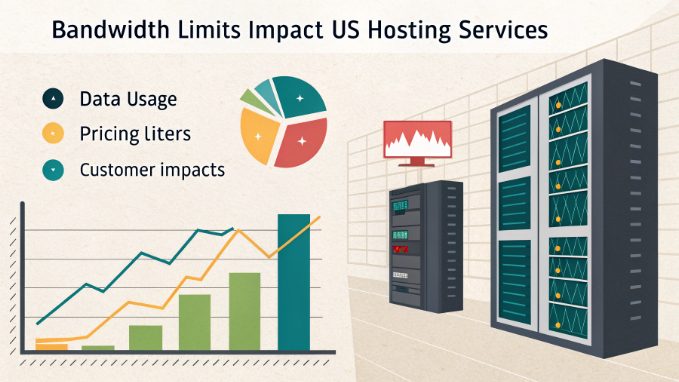What Do Bandwidth Limits Mean for US Hosting?

Understanding bandwidth limits on US hosting is crucial for tech professionals managing web infrastructure. As data transfer volumes continue to grow exponentially, grasping the implications of bandwidth restrictions becomes increasingly vital for optimal server performance and cost management. In 2025, with the proliferation of high-definition media and real-time applications, bandwidth management has become more critical than ever.
Understanding Server Bandwidth Fundamentals
In the realm of hosting servers, bandwidth represents the maximum rate of data transfer across a network connection. Think of it as a digital highway where data packets travel – the wider the highway, the more traffic it can handle simultaneously. Modern hosting environments typically operate on high-speed networks capable of handling multiple gigabits per second.
Key Bandwidth Metrics (2025 Standards):
- Entry-level hosting: 100 Mbps – 1 Gbps
- Business-grade hosting: 1 Gbps – 10 Gbps
- Enterprise solutions: 10 Gbps – 100 Gbps
- High-frequency trading: 400 Gbps+
| Bandwidth Tier | Typical Usage | Monthly Transfer Limit | Cost Level |
|---|---|---|---|
| Basic | Small websites, blogs | 1 TB | Entry-level |
| Professional | E-commerce, media sites | 5 TB | Mid-range |
| Enterprise | High-traffic applications | Unlimited | Premium |
Bandwidth Measurement and Monitoring
- Data Transfer Metrics:
- Bits per second (bps) – base unit of measurement
- Megabits per second (Mbps) = 1,000,000 bps
- Gigabits per second (Gbps) = 1,000 Mbps
- Terabits per second (Tbps) = 1,000 Gbps
- Real-world Performance Factors:
- Network overhead: 2-8% loss
- Protocol efficiency: 85-90%
- Peak usage variations: ±30%
- Geographic distance impact: 5-15% degradation per 1000 miles
Common Bandwidth Limitation Models
1. Usage-Based Billing
- Pay-as-you-go model
- Variable rates based on usage volume
- Volume discounts available
- Premium rates for excess usage
- Monitoring Requirements
- Real-time usage tracking
- Automated alerts at 80% threshold
- Monthly usage reports
2. Peak Bandwidth Limits
- Speed Caps
- Standard: 100 Mbps – 1 Gbps
- Premium: 1 Gbps – 10 Gbps
- Ultra: 10 Gbps+
- Burst Capabilities
- Short-term: +50% for 30 minutes
- Medium-term: +30% for 2 hours
- Long-term: +10% for 24 hours
3. Unmetered Bandwidth
- 1 Gbps: Entry-level tier
- 10 Gbps: Professional tier
- 40 Gbps: Business tier
- 100 Gbps: Enterprise tier
Impact on Website Operations
Performance Metrics
- Page Load Times
- Optimal: < 1.5 seconds
- Acceptable: 1.5-3 seconds
- Poor: > 3 seconds
- Concurrent User Capacity
- Basic browsing: 50 Kbps per user
- Media streaming: 5-15 Mbps per user
- Interactive applications: 1-2 Mbps per user
// Calculate required bandwidth
function calculateBandwidth(users, userType) {
const usagePatterns = {
'basic': 0.05, // 50 Kbps
'streaming': 10, // 10 Mbps
'interactive': 1.5 // 1.5 Mbps
};
const overhead = 1.2; // 20% overhead
return users * usagePatterns[userType] * overhead;
}
Optimization Techniques
1. Content Delivery Optimization
- CDN Implementation
- Global edge locations: 150+ POPs
- Cache hit ratio: 95-99%
- Latency reduction: 40-60%
- File Optimization
- Image compression: WebP, AVIF formats
- Video streaming: Adaptive bitrate
- Code minification: 30-60% reduction
2. Protocol Optimization
- Modern Protocols
- HTTP/3 implementation
- QUIC transport layer
- TLS 1.3 encryption
- Connection Management
- Keep-alive optimization
- Connection pooling
- DNS pre-fetching
Monitoring and Analytics
Real-time Monitoring Tools
- Key Metrics
- Bandwidth utilization
- Latency measurements
- Error rates
- Throughput statistics
- Alert Thresholds
- Warning: 80% capacity
- Critical: 90% capacity
- Emergency: 95% capacity
Cost Management Strategies
1. Resource Optimization
- Traffic Shaping
- Peak hour management
- Content prioritization
- Rate limiting
- Infrastructure Planning
- Capacity forecasting
- Scaling thresholds
- Redundancy planning
2. Cost Analysis
- Infrastructure costs vs. performance gains
- Optimization investment returns
- Long-term scaling economics
Future Trends (2025-2026)
- Emerging Technologies
- AI-driven optimization
- Quantum networking integration
- Edge computing expansion
- Infrastructure Evolution
- 400G ethernet adoption
- Automated scaling systems
- Green computing initiatives
Conclusion
Understanding and managing bandwidth limits on US hosting servers remains a critical aspect of modern web infrastructure. As we progress through 2025 and beyond, the importance of efficient bandwidth management continues to grow. Organizations must stay informed about the latest technologies and best practices while maintaining a balance between performance, cost, and scalability.
- Implement comprehensive monitoring systems
- Utilize modern optimization techniques
- Plan for future bandwidth requirements
- Balance cost with performance needs
- Stay updated with emerging technologies

